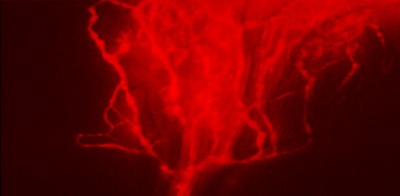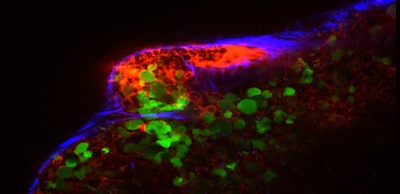Lymph function
Although, lymphatic vessels are responsible for both draining interstitial fluid from tissues and for transporting immune cells to lymph nodes to maintain the body/s immune surveillance, the focus of our research in the Steele Laboratory is on the fluid balance aspect of lymphatic function. We use fluorescence microlymphangiography to identify functional lymphatic vessels in vivo (Leu et al., Am. J. Phys 1994).

Multiphoton microscopy image of lymphatic vessels of the mouse tail (Padera et al., Molecular Imaging, 2002). Scale bar=200 um.

Intravital microscopy image of blood (green) and lymphatic (red) vessels of the mouse ear (Hoshida et al., Cancer Research, 2006). Scale bar=850 um.
In tumors, there seems to be a lack of functional lymphatic vessels (Padera et al., Science, 2002). This results in an elevated fluid pressure in tumors, forming a critical barrier to the homogeneous distribution of drugs throughout the tumor (Jain et al., Cancer Research 2007). We have measure fluid pressure in hundreds of tumors in patients and have found it consistently elevated over normal tissue levels (Jain, Scientific American 1994). How novel targeted therapies affect tumor interstitial fluid pressure is being explored as part of our Clinical Trials.
